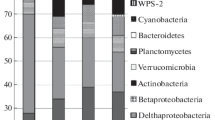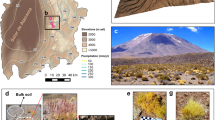Abstract—
The composition of rhizosphere microbial communities was studied for different species and varieties of agricultural gramineous plants (rye and wheat) grown in the soils contrasting in a number of agrochemical parameters. The data on analysis of the rhizosphere microbial communities obtained by sequencing of the V4 variable region of the 16S rRNA gene and on the ion and mass spectral composition of soil extracts are presented. Alpha diversity indices of the rhizosphere and control communities were almost the same. Analysis of beta diversity revealed higher variability of the rhizosphere microbial communities for chernozem-grown plants. Rhizosphere communities of the plants grown on sod-podzol soil were more similar and formed separate clusters. The taxa reliably involved in formation of specific rye and wheat rhizosphere microbiomes were established. Both common rhizosphere taxa (Sphingobacteriia, Betaproteobacteria) and species- or variety-specific ones (Oxalobacteraceae, Sphingobacteriaceae) were determined. Ion concentrations in soil extracts varied significantly depending on the soil type, while the similarity of mass spectral profiles depended more on the plant species than on the soil type.



Similar content being viewed by others
REFERENCES
Aira, M., Gómez-Brandón, M., Lazcano, C., Baath, E., and Domínguez, J., Plant genotype strongly modifies the structure and growth of maize rhizosphere microbial communities, Soil Biol. Biochem., 2010, vol. 42, pp. 2276–2281.
Andronov, E.E., Pinaev, A.G., Pershina, E.V., and Chizhevskaya, E.P., Nauchno-metodicheskie rekomendatsii po vydeleniyu vysokoochishchennykh preparatov DNK iz ob’’ektov okruzhayushchei sredy (Scientific and Methodical Recommendations for Isolation of Highly Purified DNA Preparations from Environmental Objects), S.-Pb.: Russ. Acad. Agric. Sci., 2011.
Bates, S.T., Berg-Lyons, D., Caporaso, J.G., Walters, W.A., Knight, R., and Fierer, N., Examining the global distribution of dominant archaeal populations in soil, ISME J., 2011, vol. 5, pp. 908‒917.
Berg, G. and Smalla, K., Plant species and soil type cooperatively shape the structure and function of microbial communities in the rhizosphere, FEMS Microbiol. Ecol., 2009, vol. 68, pp. 1–13.
Bulgarelli, D., Garrido-Oter, R., Munch, P.C., Weiman, A., Dröge, J., Pan, Y., McHardy, A.C., and Schulze-Lefert, P., Structure and function of the bacterial root microbiota in wild and domesticated barley, Cell Host Microbe, 2015, vol. 17, pp. 392‒403. https://doi.org/10.1016/j.chom.2015.01.011
Caporaso, J.G., Kuczynski, J., Stombaugh, J., Bittinger, K., Bushman, F.D., Costello, E.K., Fierer, N., Peña, A.G., Goodrich, J.K., Gordon, J.I., Huttley, G.A., Kelley, S.T., Knights, D., Koenig, J.E., Ley, R.E., et al., QIIME allows analysis of high-throughput community sequencing data, Nat. Meth., 2010, vol. 7, pp. 335‒336. https://doi.org/10.1038/nmeth.f.303
Chaparro, J.M., Badri, D.V., Bakker, M.G., Sugiyama, A., Manter, D.K., and Vivanco, J.M., Root exudation of phytochemicals in Arabidopsis follows specific patterns that are developmentally programmed and correlate with soil microbial functions, PLoS One, 2013, vol. 8: e55731.
Coleman-Derr, D., Desgarennes, D., Fonseca-Garcia, C., Gross, S., Clingenpeel, S., Woyke, T., North, G., Visel, A., Partida-Martinez, L.P., and Tringe, S.G., Plant compartment and biogeography affect microbiome composition in cultivated and native Agave species, New Phytol., 2016, vol. 209, pp. 798‒811. https://doi.org/10.1111/nph.13697
De Santis, T.Z., Jr., Hugenholtz, P., Keller, K., Brodie, E.L., Larsen, N., Piceno, Y.M., Phan, R., and Andersen, G.L., NAST: a multiple sequence alignment server for comparative analysis of 16S rRNA genes, Nucleic Acids Res., 2006, vol. 34 (Web Server issue), pp. W394‒W399.
Donn, S., Kirkegaard, J.A., Perera, G., Richardson, A.E., and Watt, M., Evolution of bacterial communities in the wheat crop rhizosphere, Environ. Microbiol., 2015, vol. 17, pp. 610‒621.
Edwards, J., Johnson, C., Santos-Medellín, C., Lurie, E., Podishetty, N.K., Bhatnagar, S., Eisen, J.A., and Sundaresan, V., Structure, variation, and assembly of the root-associated microbiomes of rice, Proc. Natl. Acad. Sci. U. S. A., 2015, vol. 112, pp. E911‒E920. https://doi.org/10.1073/pnas.1414592112
Girvan, M.S., Bullimore, J, Pretty, J.N., Osborn, A.M., and Ball, A.S., Soil type is the primary determinant of the composition of the total and active bacterial communities in arable soils, Appl. Environ. Microbiol., 2003, vol. 69, pp. 1800–1809. https://doi.org/10.1111/1462-2920.12452
Gottel, N.R., Castro, H.F., Kerley, M., Yang, Z., Pelletier, D.A., Podar, M., Karpinets, T., Uberbacher, E., Tuskan, G.A., Vilgalys, R., Doktycz, M.J., and Schadt, C.W., Distinct microbial communities within the endosphere and rhizosphere of Populus deltoides roots across contrasting soil types, Appl. Environ. Microbiol., 2011, vol. 77, pp. 5934‒5944. https://doi.org/10.1128/AEM.05255-11
Hammer, O., Harper, D., and Ryan, P., PAST: Paleontological Statistics software package for education and data analysis, Paleontologia Electronica,. 2001, vol. 4, article 4.
Handelsman, J., Metagenomics: application of genomics to uncultured microorganisms, Microbiol. Mol. Biol. Rev., 2004, vol. 68, pp. 669–685.
Ivlev, A.M. Evolyutsiya pochv (Evolution of Soils), Vladivostok: Far Eastern Univ., 2005.
Knief, C., Delmotte, N., Chaffron, S., Stark, M., Innerebner, G., Wassmann, R., von Mering, C., and Vorholt, J.A., Metaproteogenomic analysis of microbial communities in the phyllosphere and rhizosphere of rice, ISME J., 2012, vol. 6, pp. 1378‒1390. https://doi.org/10.1038/ismej.2011.192
Lozupone, C.A., Hamady, M., Kelley, S.T., and Knight, R., Quantitative and qualitative beta diversity measures lead to different insights into factors that structure microbial communities, Appl. Environ. Microbiol., 2007, vol. 73, pp. 1576‒1585.
Lundberg, D.S., Lebeis, S.L., Paredes, S.H., Yourstone, S., Gehring, J., Malfatti, S., Tremblay, J., Engelbrektson, A., Kunin, V., del Rio, T.G., Edgar, R.C., Eickhorst, T., Ley, R.E., Hugenholtz, P., Tringe, S.G., and Dangl, J.L., Defining the core Arabidopsis thaliana root microbiome, Nature, 2012, vol. 488, pp. 86‒90.
Mendes, L.W., Kuramae, E.E., Navarrete, A.A., van Veen, J.A., and Tsai, S.M., Taxonomical and functional microbial community selection in soybean rhizosphere, ISME J., 2014, vol. 8, pp. 1577‒1587. https://doi.org/10.1038/ismej.2014.17
Peiffer, J.A., Spor, A., Koren, O., Jin, Z., Tringe, S.G., Dangl, J.L., Buckler, E.S., and Ley, R.E., Diversity and heritability of the maize rhizosphere microbiome under field conditions, Proc. Natl. Acad. Sci. U. S. A., 2013, vol. 110, pp. 6548‒6553.
Winston, M.E., Hampton-Marcell, J., Zarraonaindia, I., Owens, S.M., Moreau, C.S., Gilbert, J.A., Hartsel, J.A., Kennedy, S.J., and Gibbons, S.M., Understanding cultivar-specificity and soil determinants of the cannabis microbiome, PLoS One, 2014, vol. 9. e99641.
Funding
This work was supported by the Russian Science Foundation (project no. 41-26-00049P, “Analysis of the Genetic and Evolutionary Potential of Soil Microbiome for Increasing Plant Productivity and Soil Fertility”) using the equipment of the Genome Technologies and Cell Biology Common Use Center, All-Russian Research Institute of Agricultural Microbiology. The text of the article was prepared using the funds of the RSF project no. 18-16-00073.
Author information
Authors and Affiliations
Corresponding author
Ethics declarations
The authors declare that they have no conflict of interest. This article does not contain any studies involving animals or human participants performed by any of the authors.
Additional information
Translated by E. Babchenko
Rights and permissions
About this article
Cite this article
Zverev, A.O., Pershina, E.V., Shapkin, V.M. et al. Molecular Analysis of the Rhizosphere Microbial Communities from Gramineous Plants Grown on Contrasting Soils. Microbiology 89, 231–241 (2020). https://doi.org/10.1134/S002626172001018X
Received:
Revised:
Accepted:
Published:
Issue Date:
DOI: https://doi.org/10.1134/S002626172001018X




